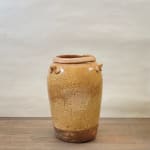









artisan's name unknown
Seto Kannyu Mimitsuki Tsubo, circa late 1800s
pottery
9" X 3 1/2"
Further images
-
(View a larger image of thumbnail 1
)

-
(View a larger image of thumbnail 2
)

-
(View a larger image of thumbnail 3
)

-
(View a larger image of thumbnail 4
)

-
(View a larger image of thumbnail 5
)

-
(View a larger image of thumbnail 6
)

-
(View a larger image of thumbnail 7
)

-
(View a larger image of thumbnail 8
)

-
(View a larger image of thumbnail 9
)

-
(View a larger image of thumbnail 10
)

Meet Seto ware, a humble utilitarian vessel from the late 1800s, once used for storing oil, soy sauce, or water in kitchens. Japanese ceramics have captivated us all with their...
Meet Seto ware, a humble utilitarian vessel from the late 1800s, once used for storing oil, soy sauce, or water in kitchens.
Japanese ceramics have captivated us all with their enigmatic charm, offering a window into their rich history and unique aesthetics. At the heart of this seduction is the concept of Keshiki, 'landscape,' or 'view,' which describes the journey of a ceramic piece from its birth in the hands of an artisan to the kiln and to the collector's hands. Keshiki evolves over time through glaze color development, kiln conditions, and how it has been handled with many hands. Its beauty lies in individuality and constant evolution, making each piece unique. Collectors seek ceramics that narrate intriguing tales through their Keshiki, embracing imperfection and transience. Let's explore the intricacies of a jar from Seto ware (瀬戸焼, created in Seto City in Today's Aichi-Prefecture).
Enjoy the Keshiki of the jar from multiple angles with these photos.
Keshiki, 'landscape' or 'view,' is etched onto the ceramic surface over time, capturing the passage of time. Its beauty lies in unpredictability, offering a unique narrative in every piece. This jar transcends its primary function, standing as an artistic expression of time, nature, and life itself. Its Keshiki reflects the beauty of change and the transient nature of existence like an ever-changing landscape viewed from a window.
The jar presents an unusual opportunity to hold the narrative of its long journey in your hands. Imagine the captivating conversations it will spark with you, the serene tranquility it will impart to your living space, and the profound sense of connection to a greater narrative.
You slip into its narrative and become an element of Keshiki.
Japanese ceramics have captivated us all with their enigmatic charm, offering a window into their rich history and unique aesthetics. At the heart of this seduction is the concept of Keshiki, 'landscape,' or 'view,' which describes the journey of a ceramic piece from its birth in the hands of an artisan to the kiln and to the collector's hands. Keshiki evolves over time through glaze color development, kiln conditions, and how it has been handled with many hands. Its beauty lies in individuality and constant evolution, making each piece unique. Collectors seek ceramics that narrate intriguing tales through their Keshiki, embracing imperfection and transience. Let's explore the intricacies of a jar from Seto ware (瀬戸焼, created in Seto City in Today's Aichi-Prefecture).
Enjoy the Keshiki of the jar from multiple angles with these photos.
Keshiki, 'landscape' or 'view,' is etched onto the ceramic surface over time, capturing the passage of time. Its beauty lies in unpredictability, offering a unique narrative in every piece. This jar transcends its primary function, standing as an artistic expression of time, nature, and life itself. Its Keshiki reflects the beauty of change and the transient nature of existence like an ever-changing landscape viewed from a window.
The jar presents an unusual opportunity to hold the narrative of its long journey in your hands. Imagine the captivating conversations it will spark with you, the serene tranquility it will impart to your living space, and the profound sense of connection to a greater narrative.
You slip into its narrative and become an element of Keshiki.
Signup for our Newsletter
You will receive two emails a month from us. One introduces artworks and design works from Kyoto's hidden sources and the other is stories from Misako, sharing insights into Japanese culture.
* denotes required fields
为了回应您的查询,我们将根据我们的隐私政策处理您提供的个人数据。